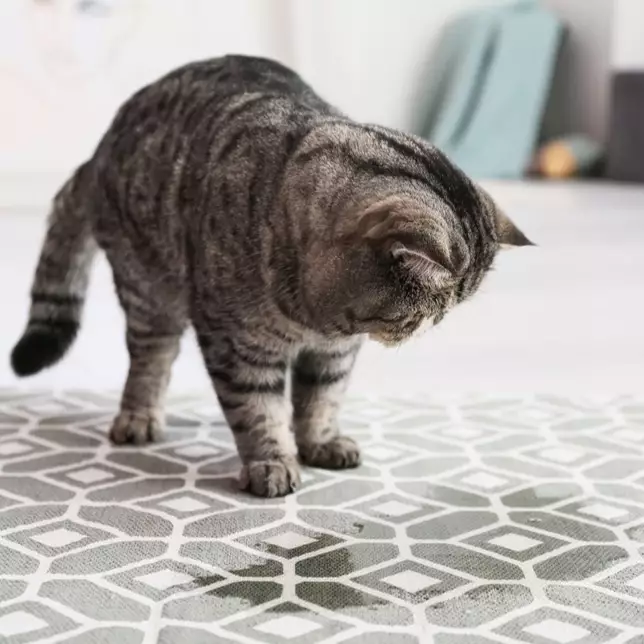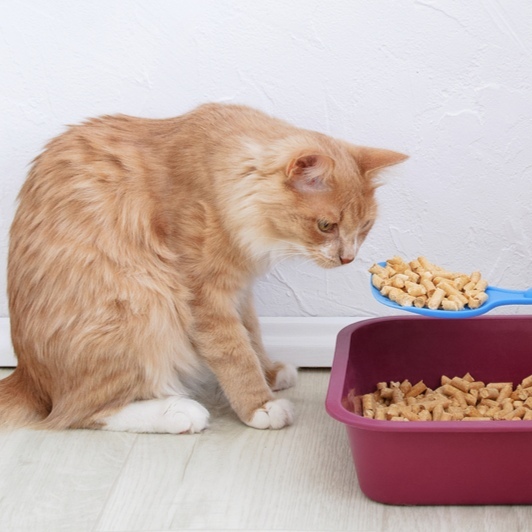Lymphadenopathy in cats
What is lymphadenopathy in cats?
Lymphadenopathy is a broad term used to describe enlarged or swollen lymph nodes. The lymph nodes are part of the lymphatic system, a network of tissues and organs that help rid the body of toxins, waste and other unwanted materials. The primary function of the lymphatic system is to transport lymph, a fluid containing infection-fighting white blood cells, throughout the body.
The lymph nodes are small, bean-shaped soft nodules of tissue which play an essential role in the functioning of the immune system, acting as filters for the blood and as storage places for white blood cells. Lymphatic ducts are a series of tube-like structures which pick up excess fluid leaked from the blood capillaries, filter out any toxins and return healthy blood back to the bloodstream.
When an infection occurs in the body, the regional lymph nodes close to the site of the infection become inflamed and swollen. This swelling occurs because of an immune system response; an increase of white blood cells (lymphocytes) occurs in the presence of an infectious agent. Lymph fluid passes through the lymph nodes, where infectious materials such as bacteria, viruses, fungi and cancer cells are trapped and destroyed by lymphocytes. The processes of destroying infectious materials cause the lymph node to become inflamed, therefore, the lymph nodes are often the first indicators of disease in the adjacent tissues.
There are three main types of swollen lymph nodes:
Lymphoid reactive hyperplasia:
This is the normal response of the lymph nodes when reacting to an antigenic stimulus (a substance that stimulates production of an antibody, such as a virus or toxin). The lymph nodes produce an excess of white blood cells and are therefore enlarged but are not themselves infected.
Lymphadenitis:
This is an inflammation and infection of the lymph nodes, usually in response to an infection that started elsewhere in the body. It is a common complication of many infections.
Cancer:
Cancer cells found in the lymph nodes can be either a lymphoma, a primary cancer originating in the lymph node, or a metastasis,a secondary cancer that has spread from another location in the body.
Lymph node locations:
- Below the jaw – submandibular
- Cervical – neck
- Armpits – axillary
- Chest – tracheobronchial
- Mesentery/intestines – mesenteric
- Pelvis – iliac
- Groin -inguinal
- Rear leg, close to the knee – popliteal
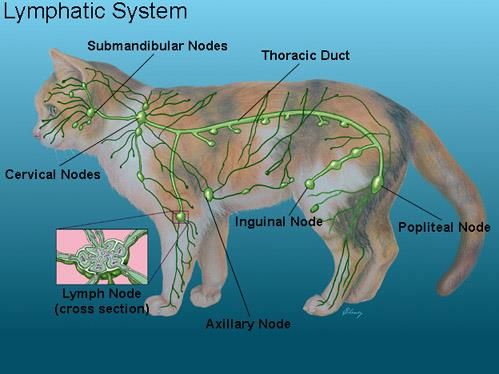
Lymphadenopathy in cats. Lymphatic system of the cat. Lymphoma in cats.
Source: https://i.pinimg.com/originals/e8/05/59/e80559bb1465c071ffbf84149436f29f.jpg
Symptoms of lymphadenopathy in cats
Swollen lymph nodes are the main symptom, detectable as a lump under the skin. Lymphadenopathy caused by infections are usually painful to the touch and are accompanied by symptoms associated with the illness. However, lymphadenopathy caused by non-infectious conditions, such as cancer, will cause the lymph node to swell but often no pain or accompanying will symptoms will be present.
Generalised symptoms of lymphadenopathy in cats caused by infections include:
- A lump underneath the skin
- Localised pain
- Fever
- Fluid build-up
- Polyuria – excessive urination
- Polydipsia – excessive thirst
- Vomiting
- Diarrhoea
- Lethargy
- Anorexia – loss of appetite
- Weight loss
- Runny nose
Other symptoms associated with lymphadenopathy can be are specific to the infection or underlying cause, for example:
- If your cat has a dental abscess, the lymph nodes in the throat may become enlarged, which could cause difficulty swallowing, a decreased appetite, and weight loss.
- An enlarged lymph node of the limbs could make it difficult for the cat to walk, causing a decrease in physical activity, unusual gait, and swelling of one limb.
- Swollen nodes in the area near the groin (inguinal) may make defecation difficult.
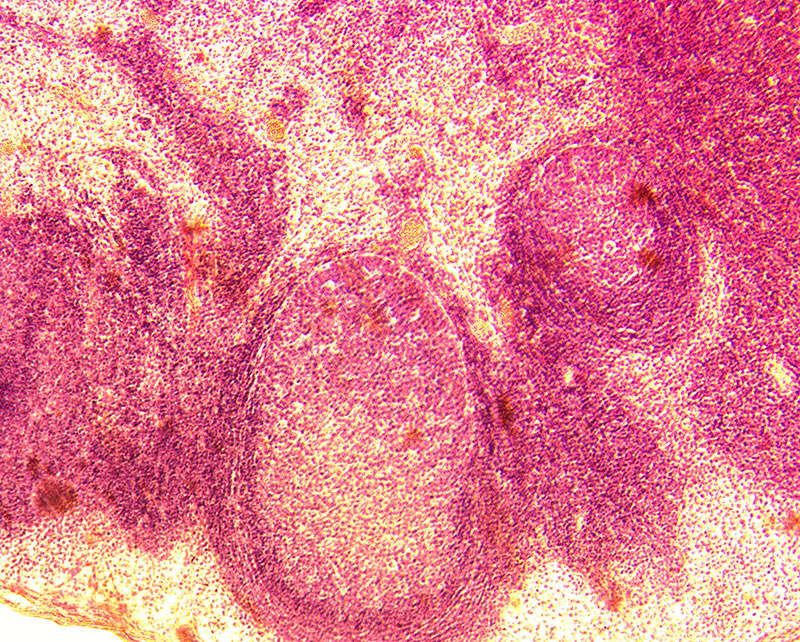
Domestic cat (Felis catus) stained lymph node – (stained by haematoxylin – eozin) – permanent slide plate under high magnification
Causes of lymphadenopathy in cats
Lymphadenopathy in cats can be caused by numerous infectious and non-infectious agents.
Allergens:
An allergen is a non-infectious agent or substance that causes an allergic reaction in the body. Lymph nodes respond to allergens in the body by producing excess white blood cells, usually in the nodes near the site of the reaction, causing these to swell.
The following substances can cause allergic reactions in cats:
- Food
- Fleas and flea-control products
- Tree, grass, weed, mould, mildew and dust pollens
- Cleaning products
- Prescription drugs
- Perfumes
- Fabrics
- Rubber and plastic materials
- Cigarette smoke
Infections:
There are also many infectious causes of enlarged lymph nodes in cats. Some of these are:
Viral:
- Feline immunodeficiency virus (FIV)
- Feline coronavirus
- Calicivirus polyarthropathy or stomatitis
- Feline panleukopenia virus (FPV)
- Feline leukemia virus (FeLV)
Bacterial:
- Rickettsia (transmitted by ticks, mites and fleas)
- Bartonella spp (transmitted by biting flies)
- Brucella canis (sexually transmitted)
- Pasteurella (commonly found in the mouths of cats and dogs)
- Yersinia pestis (transmitted by fleas; also known as “the plague”)
- Mycobacterium (transmitted by infected water supply)
Fungal:
- Histoplasma capsulatum (ingested through contaminated soil or bird droppings)
- Sporotrichosis: fungal infection acquired from plants through wounds on the skin
Protozoal:
- Toxoplasma gondii (found in garden soil and raw meat)
How is lymphadenopathy in cats diagnosed?
It is important to see a veterinarian to determine the cause of swollen lymph nodes. The age of the cat can narrow down probable cause; infections are more common in young cats and cancer more probable in old cats.
The vet will perform a complete physical examination and evaluate the swollen gland(s). The number of affected glands, size and location can indicate the underlying cause. If the lymph node is close to the skin’s surface, the vet may be able to feel the localised enlargement. A medical history will be necessary, including a description of any other symptoms or recent infections, which may indicate if any organs are causing secondary enlargement of the regional lymph nodes.
Diagnosis will usually require tests to evaluate organ function and look for signs of infection or inflammation, which may include:
- Serum chemistry profile
- Complete blood count
- Urinalysis
- Electrolyte panel
- Fine needle aspiration – a small needle is inserted into the lymph node and a sample of fluid is taken and evaluated under microscope by a pathologist.
- Lymph node biopsy – Removal of lymph node tissue for evaluation by a pathologist.
- Tests for feline leukaemia virus and feline immunodeficiency virus.
- Serologic (blood serum) tests for antibodies to systemic fungal agents or bacteria.
- Faecal parasitology examination
- Ultrasound or x-ray – To evaluate the lymph nodes and look for possible tumours; ultrasounds are preferred as they are more effective than x-rays in viewing an enlarged lymph node.
If lymph nodes remain swollen and infection and allergy have been ruled out as the cause, your vet will conduct further diagnostic tests to look for cancer.
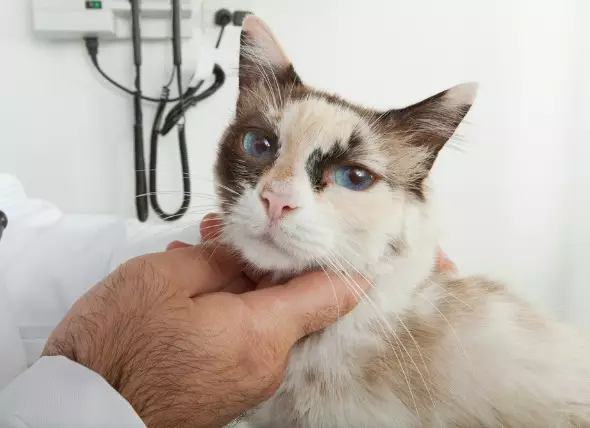
Lymphadenopathy in cats. Enlarged lymph nodes in cats. Lymphoma in cats.
Source: https://www.petmd.com/sites/default/files/lymph-node-inflammation-lymphadenitis-cats.jpg
Prognosis
In most cases, lymphadenopathy in cats is not serious and the majority of cats make a complete recovery. To receive a positive prognosis, the cause of lymphadenopathy must be determined in order to treat and manage the condition effectively. In a small percentage of cases, lymphadenopathy is caused by cancer, which carries a less optimistic prognosis. If the cancer has spread from another location (metastasised), the prognosis is generally poor.
Treatment for lymphadenopathy in cats
The prescribed treatment options for lymphadenopathy in cats depend largely on the underlying cause of the lymph node enlargement.
Infections are generally treated with oral or intravenous medications to eradicate the infectious agent:
- Viral infections are treated with supportive care such as fluid therapy and nutritional support; the cat’s own immune system fights off the virus.
- Bacterial infections are treated with antibiotics.
- Fungal infections are treated with antibiotics or anti-fungals along with supportive care.
- Inflammation may be treated with anti-inflammatory medications such as cortisone.
Treatment for lymphadenopathy caused by cancer usually entails a combination of the following:
- Surgical removal of the affected lymph node
- Chemotherapy
- Radiation therapy
In a nutshell
Lymphadenopathy is a broad term for the condition of enlarged lymph nodes that commonly occurs when there is infection or disease in the body’s tissues. Swelling ensues from the increased number of white blood cells in the lymph nodes as an immune-system response to an infection. Lymph nodes may also enlarge in response to allergens or, in worst case scenario, as a sign of a primary (lymphoma) or secondary cancer (metastasis) from elsewhere in the body.
The principal symptom of lymphadenopathy is a swollen lump under the skin that is usually painful to the touch and that may be accompanied by symptoms associated with the underlying infection or illness. The goal of diagnosis is to identify the underlying cause, and treatment usually entails medication aimed at eradicating this. In most cases, enlarged lymph nodes in cats is not a serious condition and most animals make a full recovery.
Bow Wow Meow Pet Insurance can help protect you and your cat should an unexpected trip to the vet occur.
-
Find out more about our cat insurance options
-
Get an online pet insurance quote
Bow Wow Meow is proud to have been awarded winner of Canstar’s ‘Most Satisfied Customers’ Award in the Pet Insurance category for both 2024 and 2025!
Bow Wow Meow is proud to have been chosen as Product Review’s Pet Insurance Award Winner every year from 2018 to 2025! This is based on 2,995 independent customer reviews (as at 21/01/2025), with an overall rating of 4.3*
Google Review rating = 4.5* (based on 968 reviews)
Trust Pilot rating = 4.6* (based on 531 reviews)
Bow Wow Meow is proud to have been chosen as Product Review’s Pet Insurance Award Winner every year from 2018 to 2025! This is based on 2,995 independent customer reviews (as at 21/01/2025), with an overall rating of 4.3*
Google Review rating = 4.5* (based on 968 reviews)
Trust Pilot rating = 4.6* (based on 531 reviews)
Bow Wow Meow has been chosen as a winner in the Finder Pet Insurance Awards 2024. Finder’s panel of experts analysed over 140 quotes to award our Ultimate Care Plan the winner of the “Pet Insurance – Value” category.
More information
https://www.petmd.com/cat/conditions/cancer/c_ct_lymphadenopathy
https://wagwalking.com/cat/condition/lymphadenopathy
http://veterinarynews.dvm360.com/reviewing-causes-treatment-feline-lymphadenopathy
https://www.cat-world.com.au/swollen-lymph-nodes-in-cats.html
https://pets.thenest.com/lymphadenopathy-cats-7703.html
http://catexpert.blogspot.com/2016/12/lymph-node-enlargement-in-cat.html
https://www.livescience.com/26983-lymphatic-system.html
https://pets.webmd.com/cats/cat-allergy-symptoms-triggers#1-4





